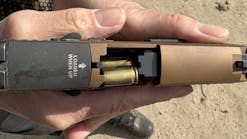The Best Training Exercises for Police Officers in the Gym
By Phil Blechman — BarBend.com
Working a police officer's schedule can be challenging. Although different Law Enforcement Agencies (LEAs) will have different schedules for their personnel, cops often work eight, 10, or 12-hour shifts that involve higher stress levels than many desk jobs, particularly if working night shifts. (1) This combination of long hours and a more stressful environment often leads to a lack of work-life balance in fitness. For male police officers, working night shifts are likely to expand their waists and increase their body mass indexes. (2) In Laymen's terms, it can be challenging to stay fit while working as a police officer.
For law enforcement officers, improved fitness (read: periodized strength and conditioning training) reduces injury risk and enhances task performance while on the job. (3) So what are the most efficient workouts law enforcement officers can do to fend off the fate of a loosening belt? Let's dive in.
Supersets
When it comes to efficiency in the gym, it's a matter of eliminating downtime without burning out before the target workload is complete. Supersets enhance training efficiency and reduce training time. (4) In strength training, supersets are when an athlete performs two different movements back-to-back without pausing to rest between sets.
Supersets almost certainly create a better rate of perceived exertion (RPE) and potentially increase testosterone levels for up to a full day post-training. If the goal is to pack on muscle mass, supersets are the best option for greater total training volume. (5)
Here are some examples of supersets to perform next time in the gym. For gymgoers who already have their programming and need to adjust it to accommodate supersets, keep in mind to pair exercises that target opposing major muscle groups (e.g., chest and back or shoulders and abdominals). This is to prevent exhausting one muscle group too soon. For example, when supersetting chest and back, the check is under less stress during back-focused movements and vice versa.
Superset One
Chest Flye — 4 x 10-12
Bent-Over Row — 4 x 10-12
Superset Two
Lateral Raises — 4 x 10-12
Hanging Knee Raises — 4 x 10
Superset Three
Straight-Arm Pushdown — 4 x 10-12
Incline Bench Press — 4 x 10-12
Superset Four
Overhead Press — 4 x 10-12
Russian Twist — 4 x 10-12
What makes supersets such a valuable training option is the amount of flexibility. Energy expenditure is higher in a shorter period when utilizing supersets, and therefore will likely require more recovery time between training sessions. (6) Maintaining a consistent training program via supersets can be done by swapping exercises for muscle groups that need more recovery time. Is your chest feeling too sore from training? Swap in leg training alongside shoulders. The combination possibilities for supersets are high and can help get you in and out of the gym quickly while achieving results.
Mobility & Agility
The attire of a police officer can offer protective benefits but at the cost of mobility. Individual Light Armour Vests (ILAVs) that some Cops are required to wear can significantly affect mobility, increasing the risk of injury and decreasing the ability to complete occupational tasks compared to normal station wear. (7)
A 2019 study in the International Journal of Environmental Research and Public Health found that "upper-body and trunk endurance, lower-body power, and aerobic fitness become increasingly important" when carrying out tasks while wearing "occupational loads." (8) Agility performance improved while not wearing that attire. Therefore, mobility and agility training can prove beneficial to police officers' programming.
Adding balance-focused movements, plyometrics, and exercises that involve sharp changes in direction into a strength training program has been shown to improve agility. (9) Additionally, training with a partner can boost results as well. Agility improves significantly faster when trained in competitive conditions. (10)
Every Minute on the Minute (EMOM)
An EMOM involves performing a series of exercises as quickly as possible, then resting for the remaining time each minute. For example, if an athlete completes all reps of an EMOM in 45 seconds, they rest the remaining 15 seconds before starting the next set.
Minutes one through eight:
Lunges — 10 reps each leg (20 total)
Eight Burpees
Rest two minutes.
Minutes 10 through 18:
10 Box Jumps
12 Push-Ups
Rest two minutes.
Minutes 20 through 28:
20 Toes-to-Bar
10 Dumbbell Thrusters
Rest two minutes. Stretch to cool down.
The above workout is an example of a fast-paced option that uses a trio of supersets for a 30-minute training session. It should be viewed as a customizable template for your needs — extending or shortening the workout duration, increasing the intensity by limiting the rest times between sets, or changing the exercises to target your specific training goals better.
Right To Remain Fit
The demanding schedules of police officers can make it difficult to train in the gym, but having a training plan with a goal for each session can make it easier. Science suggests that supersets are one of the most tools for saving time training and that law enforcement officers should utilize mobility exercises to help them perform better on duty.
References
Ma, C. C., Andrew, M. E., Fekedulegn, D., Gu, J. K., Hartley, T. A., Charles, L. E., Violanti, J. M., & Burchfiel, C. M. (2015). Shift work and occupational stress in police officers. Safety and health at work, 6(1), 25–29. https://doi.org/10.1016/j.shaw.2014.10.001
Gu, J. K., Charles, L. E., Burchfiel, C. M., Fekedulegn, D., Sarkisian, K., Andrew, M. E., Ma, C., & Violanti, J. M. (2012). Long work hours and adiposity among police officers in a US northeast city. Journal of occupational and environmental medicine, 54(11), 1374–1381. https://doi.org/10.1097/JOM.0b013e31825f2bea
Lockie, R. G., Dawes, J. J., Maclean, N. D., Pope, R. P., Holmes, R. J., Kornhauser, C. L., & Orr, R. M. (2020). The Impact of Formal Strength and Conditioning on the Fitness of Law Enforcement Recruits: A Retrospective Cohort Study. International journal of exercise science, 13(4), 1615–1629.
Weakley, J., Till, K., Read, D. B., Roe, G., Darrall-Jones, J., Phibbs, P. J., & Jones, B. (2017). The effects of traditional, superset, and tri-set resistance training structures on perceived intensity and physiological responses. European journal of applied physiology, 117(9), 1877–1889. https://doi.org/10.1007/s00421-017-3680-3
Paz, G. A., Maia, M. F., Salerno, V. P., Coburn, J., Willardson, J. M., & Miranda, H. (2019). Neuromuscular responses for resistance training sessions adopting traditional, superset, paired set and circuit methods. The Journal of sports medicine and physical fitness, 59(12), 1991–2002. https://doi.org/10.23736/S0022-4707.19.09586-0
Kelleher, A. R., Hackney, K. J., Fairchild, T. J., Keslacy, S., & Ploutz-Snyder, L. L. (2010). The metabolic costs of reciprocal supersets vs. traditional resistance exercise in young recreationally active adults. Journal of strength and conditioning research, 24(4), 1043–1051. https://doi.org/10.1519/JSC.0b013e3181d3e993
Schram, B., Orr, R., Hinton, B., Norris, G., & Pope, R. (2020). The effects of body armour on mobility and postural control of police officers. Journal of bodywork and movement therapies, 24(3), 190–194. https://doi.org/10.1016/j.jbmt.2020.03.001
Orr, R. M., Kukić, F., Čvorović, A., Koropanovski, N., Janković, R., Dawes, J., & Lockie, R. (2019). Associations between Fitness Measures and Change of Direction Speeds with and without Occupational Loads in Female Police Officers. International journal of environmental research and public health, 16(11), 1947. https://doi.org/10.3390/ijerph16111947
Makhlouf, I., Chaouachi, A., Chaouachi, M., Ben Othman, A., Granacher, U., & Behm, D. G. (2018). Combination of Agility and Plyometric Training Provides Similar Training Benefits as Combined Balance and Plyometric Training in Young Soccer Players. Frontiers in physiology, 9, 1611. https://doi.org/10.3389/fphys.2018.01611
Kovacikova, Z., & Zemková, E. (2021). The Effect of Agility Training Performed in the Form of Competitive Exercising on Agility Performance. Research quarterly for exercise and sport, 92(3), 271–278. https://doi.org/10.1080/02701367.2020.1724862



